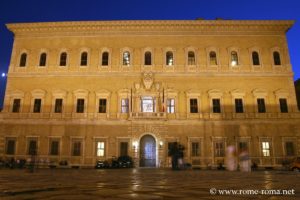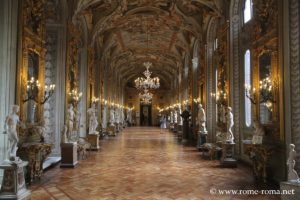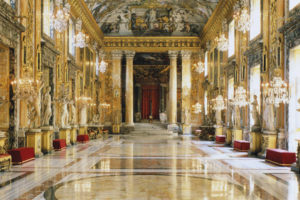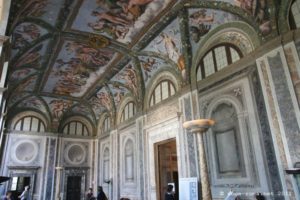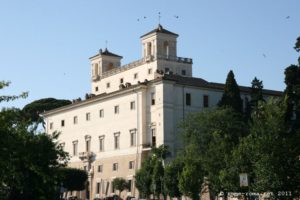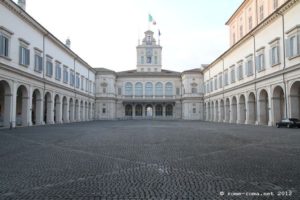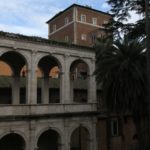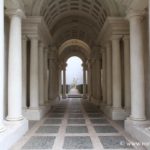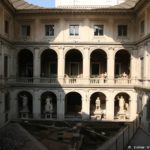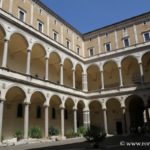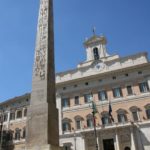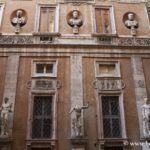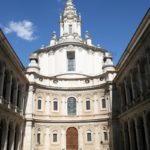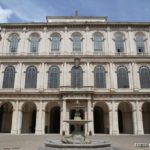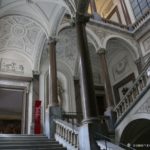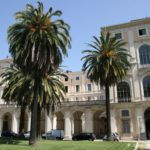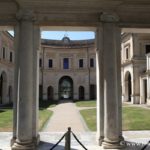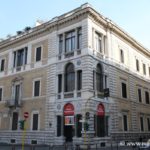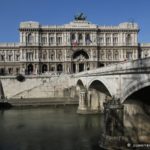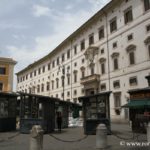After the beautiful palaces that host the prestigious museums of Rome such as the Capitoline Museums (Palazzo Nuovo, Palazzo dei Conservatori, Palazzo Senatoria), the Borghese Gallery (in the Villa Borghese), the Vatican Museums (in the Apostolic Palaces including the Raphael Rooms and the Sistine Chapel), Rome has a myriad of palaces, here are the most prestigious according to us.
Farnese Palace
The Farnese Palace (Palazzo Farnese) is the seat of the French Embassy in Italy and one of the most remarkable and accomplished palaces in Rome, built in the middle of the Renaissance in the 16th century, whose work was followed after Da Sangallo by Michelangelo and Dalla Porta.
In addition to its exterior architectural ornaments such as the beautiful cornice and atrium, the interior is remarkable with its lounges, including the prestigious Hercules Salon with its tapestries and fireplaces, the Rooms of The Splendour of the Farnese, and the famous Carrache Gallery decorated with frescoes by the Carracci brothers, as The Loves of the Gods frescoe.
* Palazzo Farnese – Piazza Farnese, 67, 00186 Roma
Doria-Pamphilj Palace
The prestigious Doria-Pamphilj Palace (Palazzo Doria-Pamphilj) dating from the 16th-18th centuries is one of the largest palaces in Rome and one of the most beautiful with its late Baroque style. It also houses the Doria-Pamphilj Gallery, a prestigious private museum that is like the palace still today owned by the historic family.
One can discover the chapel designed by Carlo Fontana, or the sumptuous hall of mirrors.
* Galleria Doria-Pamphilj – Via del Corso, 305, 00186 Roma
Colonna Palace
The Colonna Palace (Palazzo Colonna) is another of the most important palaces in Rome. It also hosts a prestigious private museum.
It was built and arranged with several wings over nearly five centuries, from the fourteenth century, passing from fortress to palace. The result is a variety of styles, both outside and inside. It became a famous baroque aristocratic residence for which worked to its embellishment great artists such as Bernini, del Grande, or Carlo Fontana. Its splendid Colonna Gallery is 76 meters long, the Fountain Room was decorated by Pinturicchio.
* Palazzo Colonna – Via della Pilotta, 17, 00187 Roma
Villa Farnesina
Built at the beginning of the 16th century for the wealthy banker Chigi on the Tiber side of Trastevere, Villa Farnesina is an emblematic Renaissance building. It was the prototype of the suburban Roman villa. It was owned by the Farnese in the 17th century.
This villa was famous for the prestigious receptions held there. but also because of the extraordinary frescoes that embellish it. Evoking ancient myths, they were painted primarily by Raphael and his school, but also by Peruzzi, Sebastiano del Piombo, Sodoma.
* Villa Farnesina, Via della Lungara, 230, 00165 Roma
Villa Medici
Located on Mount Pincio north of the historic centre, the Villa Medici has hosted the French Academy in Rome since 1803 with its winning artists and temporary exhibitions.
It is a remarkable Renaissance ensemble of the sixteenth century, with in particular in front of the opulent rear facade an Italian garden and a large park of 7 hectares.
* Villa Medici, Viale della Trinità dei Monti, 1, 00187 Roma
Quirinal Palace
Located at the top of the Quirinal hill on the square of the same name, the Quirinal Palace (Palazzo del Quirinale) is the official residence of the President of the Italian Republic. Originally a papal residence, it is one of the most important monuments in Rome from an artistic, historical and political point of view. With its 110,000 m², it is the sixth largest palace in the world. Its art collections are also remarkable (paintings, statues, tapestries, coaches, watchmaking, porcelain, etc.).
At the end of the 16th century, great Italian artists such as Domenico Fontana, Le Bernin and Carlo Maderno contributed to its construction.
* Palazzo del Quirinale, Piazza del Quirinale, 00187 Roma
Map with the palaces
If you see this after your page is loaded completely, leafletJS files are missing.
Others interesting palaces
Palazzo Venezia
The Palazzo Venezia, located in Piazza Venezia, houses a beautiful museum devoted mainly to the Renaissance and the Middle Ages. This typical Renaissance building is one of the major 15th century palaces in Rome, with its austere appearance, its battlements and massive tower, but also beautiful lounges, apartments, the main staircase, etc.
* Palazzo di Venezia, Via del Plebiscito, 118, 00186 Roma
Spada Palace
The Spada Palace (Palazzo Spada) is a beautiful 16th-17th century palace in Rome, now home to the Council of State and the small museum of the Spada Gallery. One can see in particular in the courtyard a famous gallery built by Borromini. This one has the particularity of giving the illusion of being much larger thanks to a game of perspective.
* Palazzo Spada, Piazza Capo di Ferro, 13, 00186 Roma
Altemps Palace
The Altemps Palace (Palazzo Altemps) houses an important section of the National Roman Museum dedicated to ancient sculptures.
It is a beautiful aristocratic palace built from the end of the 15th century, with a pretty corner tower serving as a belvedere, with an elegant interior courtyard in the Renaissance style, a loggia decorated with frescoes, or the small private baroque chapel of the seventeenth.
* Palazzo Altemps, Piazza di Sant’Apollinare, 46, 00186 Roma
Palace of the Chancellery
The Leonardo da Vinci Museum can be accessed from the courtyard of the Palace of the Chancellery (Palazzo della Cancelleria). This remarkable building of Renaissance style has a beautiful interior courtyard that would have been designed by Bramante by using vestiges of the theater of Pompey and the Colosseum, a loggia, a fresco by Vasari. It encompasses the former church of St. Lawrence of Damascus. This palace is owned by the Vatican where the Vatican Chancellery is located.
* Palazzo della Cancelleria, Piazza della Cancelleria, 1, 00186 Roma
- Palazzo Venezia
- Palazzo Spada (Borromini gallery)
- Palazzo Altemps
- Palazzo della Cancelleria
Montecitorio Palace
Currently the seat of the Italian parliament, the Montecitorio Palace (Palazzo di Montecitorio) has a pretty 17th century on the homonymous square, and a 20th century extension on the back to accommodate the new hemicycle. The luxurious interior is decorated with precious furniture and antique or contemporary works.
* Palazzo di Montecitorio, Piazza di Monte Citorio, 00186 Roma
Mattei di Giove Palace and Mattei Islet
The Mattei islet is a complex of palaces of the historic Roman Mattei family located on the edge of the historic ghetto. The Mattei di Giove Palace (Palazzo Mattei) was built in the early 17th century. You will discover the beautiful staircase and its two courtyards, where there are many antique ornaments and busts of emperors.
* Palazzo di Mattei di Giove, Via Michelangelo Caetani, 32, 00186 Roma
Sapienza Palace
The Sapienza Palace (Palazzo della Sapienza) is a public building, which was the seat of the University of Rome for several centuries. It has a beautiful courtyard overlooking the church of Sant’ Ivo alla Sapienza built in the 17th century by Borromini. It is a masterpiece of Baroque architecture, with its peculiar shape, dome and bold lantern.
* Palazzo della Sapienza, Corso del Rinascimento, 40, 00186 Roma
Barberine Palace
The Barberine Palace (Palazzo Barberini) houses a section of the National Museum of Ancient Art, rich in Renaissance works.
It is in the beautiful 17th century palace designed by Carlo Maderno and Francesco Borromini, with beautiful rooms, frescoes, or a spiral staircase.
* Palazzo Barberini, Via delle Quattro Fontane, 13, 00184 Roma
- Palazzo di Montecitorio
- Palazzo Mattei di Giove
- Palazzo e Church Sant’Ivo alla Sapienza
- Palazzo Barberini
Braschi Palace
The Braschi Palace (Palazzo Braschi) houses the Museum of Rome, built at the end of the 18th century. It has in particular a majestic staircase of honor, decorated with antique statues, stucco, and columns of red granite.
* Palazzo Braschi, Piazza di San Pantaleo, 10, Piazza Navona, 2, 00186 Roma
Corsini Palace
The beautiful Corsini Palace (Palazzo Corsini), located on the Trastevere side, dates from the 16th-18th centuries. It houses the other section of the Museum of Ancient Art. Its garden is part of the Botanical Garden.
* Palazzo Corsini, Via della Lungara, 10, 00165 Roma
Villa Giulia
Villa Giulia, home to the National Etruscan Museum, is a Renaissance building built in the 16th century for Pope Julius III. Intended for the resort, it was designed by the masters of the time, with Vasari, Michelangelo and Vignola. It has a beautiful semicircular courtyard, loggias, a nymphaeum decorated with Roman mosaics, or ornamental frescoes typical of the sixteenth century.
* Villa Giulia, Piazzale di Villa Giulia 9, 00196 Roma
Primoli Palace
The pretty Primoli Palace (Palazzo Primoli) houses the Napoleonic Museum and dates from the 16th century. It was owned by the husband of Charlotte Bonaparte. It was greatly overhauled in the early twentieth century, with beautiful corner bodies, beautiful entrances with columns, painted ceilings, etc.
* Palazzo Primoli, Via Giuseppe Zanardelli, 1, 00186 Roma
- Palazzo Braschi, staircase of honour
- Palazzo Corsini
- Villa Giulia
- Palazzo Primoli
Palace of Justice
Seat of the Supreme Court of Cassation, and legal institutions, the Palace of Justice (Palazzo di Giustizia) is a huge massive monument built – somehow – around the beginning of the 20th century in a marshy area. It is popularly called “palazzaccio” (dirty palace in english), due to the suspicion of corruption related to architectural excesses, its unusual dimensions and excessive decorations.
* Corte Suprema di Cassazione, Piazza Cavour, 00193 Roma
Borghese Palace
The vast Borghese Palace (Palazzo Borghese), is due to its irregular shape nicknamed «il cimbalo Borghese», the typewriter Borghese. It is a huge complex inherited from the wealth of the powerful Borghese family, usually closed to the public.
* Palazzo Borghese, Piazza Borghese, 9, 00186 Roma
- Palace of Justice
- Palazzo Borghese
Informations and map
Sources and links
- Official websites : Farnese Palace, Villa Medici, Quirinal Palace, Doria-Pamphilj Palace, Colonna Palace, and Villa Farnesina
- Wikipedia pages : Farnese Palace, Villa Medici, Quirinal Palace, Pamphilj Palace, Colonna Palace, Villa Farnesina
Map
If you see this after your page is loaded completely, leafletJS files are missing.







